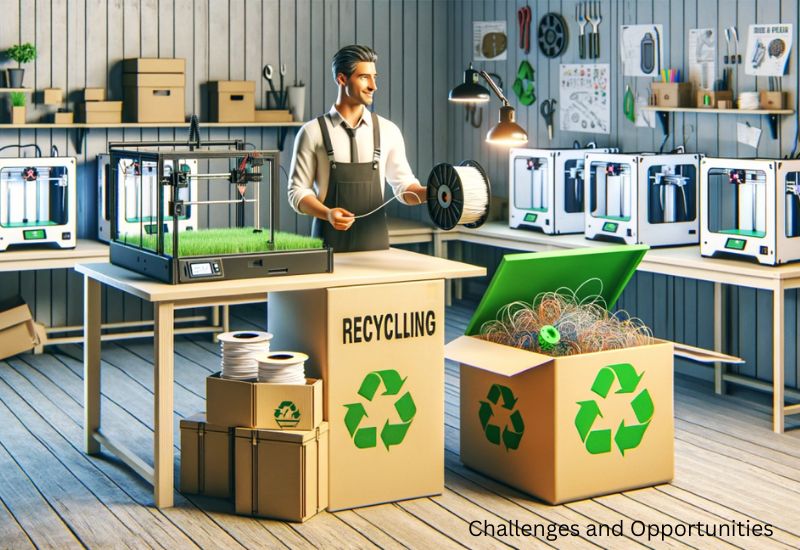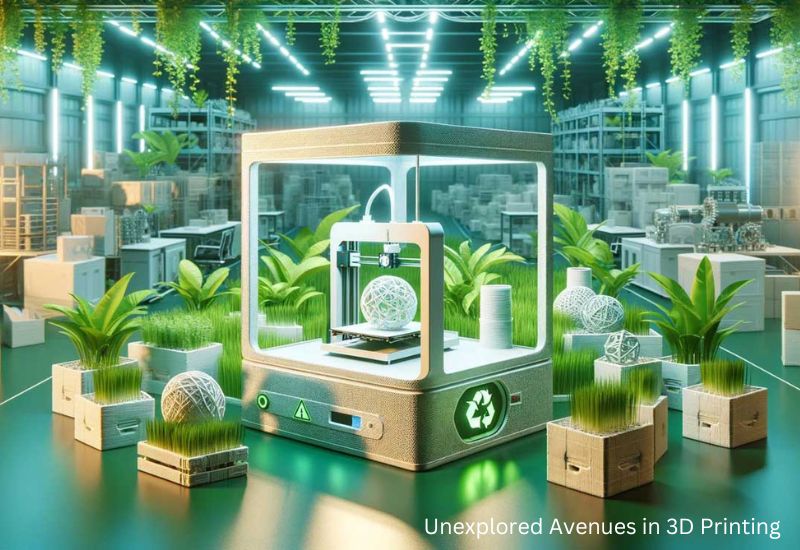3D Printing Sustainability: The 3D printing process transforms sustainability by 90%. Due to the fact that only the necessary materials are used, this optimizes economic efficiency and reduces environmental impact. In the last few years, I have witnessed 3D printing transform countless industries. The use of 3D printers allows small-scale manufacturing, reducing greenhouse gas emissions and maximizing personalization. Hobbyists and businesses can benefit from cleaner, eco-friendly manufacturing.

The Environmental Benefits of 3D Printing
Minimizing Waste in Production
3D printing uses additive manufacturing, not subtractive manufacturing. By definition, it reduces waste since only the necessary materials are used. JawsTec for example, slashed its costs by 2 tons annually by using 3D printing.
Using 3D printing for prototypes in the automotive industry is more efficient and minimizes waste. Global knitting brands also use it to reduce excess materials. Additionally, it reduces excess inventory and waste by producing items only when needed.
Moreover, 3D printing encourages localized manufacturing, reducing transportation costs. This makes it not only efficient but also environmentally friendly. For entrepreneurs, pairing Blender with the best 3d printer for small business creates a sustainable and cost-effective production setup.
Energy Efficiency in 3D Printing
A 3D printer consumes at least 64% less energy than other technologies. Its design eliminates waste. Multi-Jet Fusion is an important energy-efficient technology that uses less heat and is designed to recycle materials.
3D printing reduces storage energy costs by reducing the number of parts and the energy required to manufacture and order the components. It promotes Just-in-time manufacturing and, therefore, reduces energy use for storage.
Alternative energy sources are also possible. In addition to providing access to efficient resources without being dependent on fuel, 3D printing reduces the need for prototyping, consuming less energy.
3D printing technology is energy efficient. It helps companies and home handymen reduce their carbon footprint while maintaining quality. It also opens up creative ways to Make Money from a 3D Printer, whether through custom products, prototypes, or small-batch manufacturing.
Localized Production: Reducing Carbon Footprint
The 3D printing process greatly reduces transportation emissions by reducing the need for long shipping orders that are harmful to the environment by producing goods on the spot. The business can also sustain its employees in its surrounding areas, reducing the need to lay off employees.
The wind energy company Vestas manufactures 3D parts on site, reducing transportation costs and carbon footprints. Pulse IoT Technologies, for example, develops local sensors to eliminate logistical problems.
For this reason, companies should adopt such practices, as they would be more effective and supportive of eco-friendly business practices.

Sustainable Materials and Innovations in 3D Printing
Eco-Friendly Filaments and Materials
The environment is changing the use of 3D printing, and PLA filaments, made from India’s sugarcane and corn, are being used. PLA is highly degradable and organic. In addition to making filaments from old plastics, PLA also forms composite packaging, and plastic waste plays an important role. Terrafilum has been distributing eco-friendly materials for a long time.
US manufacturers are beginning to advertise eco-friendly materials made from natural resources. Along with PLA, other eco-friendly filaments are also becoming increasingly popular. Wood and biopolymers are vital materials that can be used for electricity and decoration and reduce the carbon footprint.
These materials are ideal for both professionals and casual creators since they are both practical and unique.
Innovative Applications Promoting Sustainability
Revitalizing Marine Ecosystems with 3D Printing
3D printing can help restore coral reefs, which are vital to ocean life. However, they are being threatened by global warming and pollution. Using environment-friendly composite materials, they encourage coral growth, leading to stronger reefs and sea organism diversity.
Transforming Construction with Sustainable Solutions
In Austin, Texas, 3D printing is being used to build houses. This method saves resources and generates less waste, resulting in a smaller carbon footprint. Despite their low cost, the houses are long-lasting and can withstand extreme weather conditions. Local and recycled materials also reduce emissions.
Eco-Conscious Designs in the Medical Sector
3D printers allow for the creation of customized implants, reducing waste and improving treatments. They also allow for the creation of artificial tissues that can be studied, used in medicine, and maintained ethically.
3D printing has many advantages regarding sustainability. It improves medicine, reconstructs ecosystems, and rehabilitates ecosystems.

Challenges and Opportunities in 3D Printing Sustainability
Addressing Sustainability Issues in 3D Printing
Current Limitations: Energy Intensity and VOC Emissions
The 3D printing process poses a few sustainability issues. It is energy-intensive, especially during the heating and cooling phases, because it needs high temperatures to melt materials.
When plastics are heated, VOCs are released. Inhaling these gases for a prolonged period can cause health problems.
Strategies for Overcoming These Challenges
Here are some simple ways to make 3D printing greener:
Use Low-Temperature Materials: Reduce VOCs and energy costs by choosing materials that melt at lower temperatures.
Improve Ventilation: Ensure that the printing area is well-ventilated by opening windows or using fans.
Install Fume Extraction Systems: For bigger setups, fume extractors can be used to filter out harmful particles.
Select Safe Filaments: PLA and PETG filaments emit fewer VOCs than ABS, which emits more harmful gases.
Three-dimensional printing can be made safer and more eco-friendly by using these strategies.
Future Prospects in 3D Printing Sustainability
This technology can be beneficial to the environment as it creates objects without wasting much material.
Greener Technologies
Vapor-induced phase separation (VIPS) is a technique that uses safe inks, conserves energy, and is lightweight for space and health.
Biodegradable Materials
Using biodegradable materials reduces waste and decomposes in nature, allowing resources to be recycled in a linear economy.
Recycling Waste
It is important to recycle. Various printed materials become garbage. Creating new products from garbage saves resources and reduces waste. Refillable spindles are a great way to reduce waste.
Circular Economy Role
3D printing maximizes resource utilization by always meeting demand. By reducing transportation distances, localized production reduces emissions, further benefiting the environment. Additional products serve no purpose, both logistically and materially.
We need to find more eco-friendly practices and ways to recycle materials and resources. 3D printing is the best way to improve the environment.

Unique Insights: Unexplored Avenues in 3D Printing Sustainability
Harnessing Community Knowledge for Sustainable Practices
Open-source communities facilitate the sharing of ideas and resources that promote creativity, which facilitates the sustainability of 3D printing.
It aims to create 3D printers that can self-replicate, reducing costs and allowing local production. RepRap is used worldwide to minimize waste and uses solar energy.
J.A.M.E.S. is another example of collaborative innovation. It enables designers and makers to share concepts and tools to enhance 3D-printed electronics.
The growth of these communities demonstrates the importance of collaboration and the ability to produce better, greener technologies through the exchange of information.
Integrating Renewable Energy with 3D Printing
The 3D printing of renewable energy sources is interesting. A better example is the 3D printers with solar energy. The printing process is carried out using the power of the sun, which minimizes reliance on conventional energy sources and is environmentally friendly.
Solar-Powered 3D Printers: How They Work
Solar 3D printers are powered by photovoltaic panels, which convert sunlight into electricity and power the printer. They work anywhere there is sunshine, making them very useful in many different places.
Benefits of Solar Energy in 3D Printing
Environmental Impact
Solar 3D printers are eco-friendly and pollutant-free. Most conventional industries burn oil.
Cost Efficiency
A solar panel system may be expensive initially, but it can save a lot of money in the long run. Once installed, solar panels emit free energy.
Energy Independence
Solar-powered printing relies less on the grid, which makes it particularly useful during power outages or remote locations. It guarantees continuous production without interruption.
New Uses for Solar 3D Printing
This technology is used in many fields, such as construction, health care, and agriculture. In construction, it enables parts of structures to be produced on-site, reducing transportation costs.
The use of biodegradable and recycled materials is another advantage of solar powered 3D printers.
Challenges and Future
Solar energy has some limitations. One of the most important factors is the weather. Energy storage is necessary for constant operation. Research is being conducted to address these challenges.
Solar 3D printing has great potential. It could be used in many industries, and this technology can contribute to a cleaner environment.
FAQ About 3D Printing Sustainability
What is sustainable 3D printing?
It uses eco-friendly materials and methods to protect the environment. The goal is to reduce waste and save energy.
How does 3D printing reduce waste?
It builds items layer by layer, using only what is needed, which results in less waste compared to traditional methods.
Can 3D printing use recycled materials?
Yes, it can use recycled plastics and metals. This helps reduce the need for new materials.
Are there eco-friendly materials for 3D printing?
Yes, materials like PLA are made from renewable resources and are biodegradable. Other options include recycled and hemp-based materials.
Does 3D printing use a lot of energy?
It usually uses less energy than traditional methods. Energy use can vary depending on the printer and materials.
How does 3D printing lower carbon emissions?
It allows local production, reducing the need for transport. Using renewable energy also cuts emissions.
Wrapping Up
Due to its ability to scale up, 3D printing has substantial environmental benefits, including less waste and better energy usage. Decentralized manufacturing also reduces emissions from the logistics side and promotes green production.
As it grows, 3D printing will also produce environmentally friendly materials and manufacturing processes. However, the positive environmental impact of 3D printing cannot be maximized without maximizing its sustainable strategies.
Read more on this sites
- Flashforge 3D Printer – Complete Overview & Buying Guide
- Flashforge Adventurer 4 Pro 3D Printer Review – Features, Pros & Cons
- Flashforge Adventurer 5M Pro 3D Printer Review – Is It Worth It?
- SUNLU S9 Plus 3D Printer Review – Big Build, Budget Price
- SUNLU S8 Pro 3D Printer Review – Features, Performance & Verdict
- SUNLU T3 3D Printer Review – Fast Printing with Smart Features
- JGMAKER A9 Pro 3D Printer Review – Affordable and Capable?
- JG Maker R1 3D Printer Review – Compact Design with Big Potential
- JGMAKER Artist-D Pro 3D Printer Review – Dual Extruder Power
- JGMAKER A5S 3D Printer Review – Beginner-Friendly Workhorse
- JGMAKER Artist-D 3D Printer Review – Budget Dual-Extruder Option
